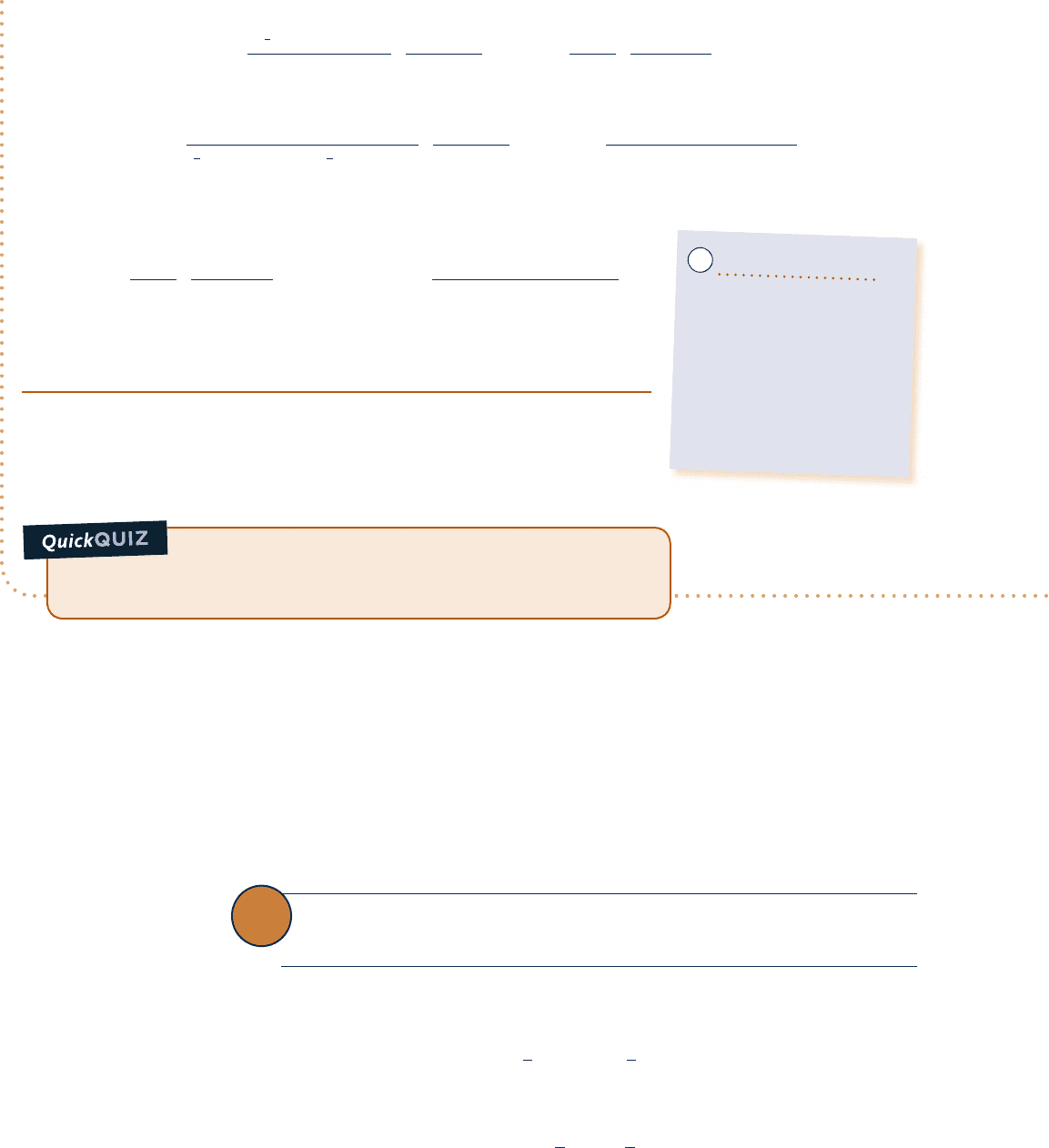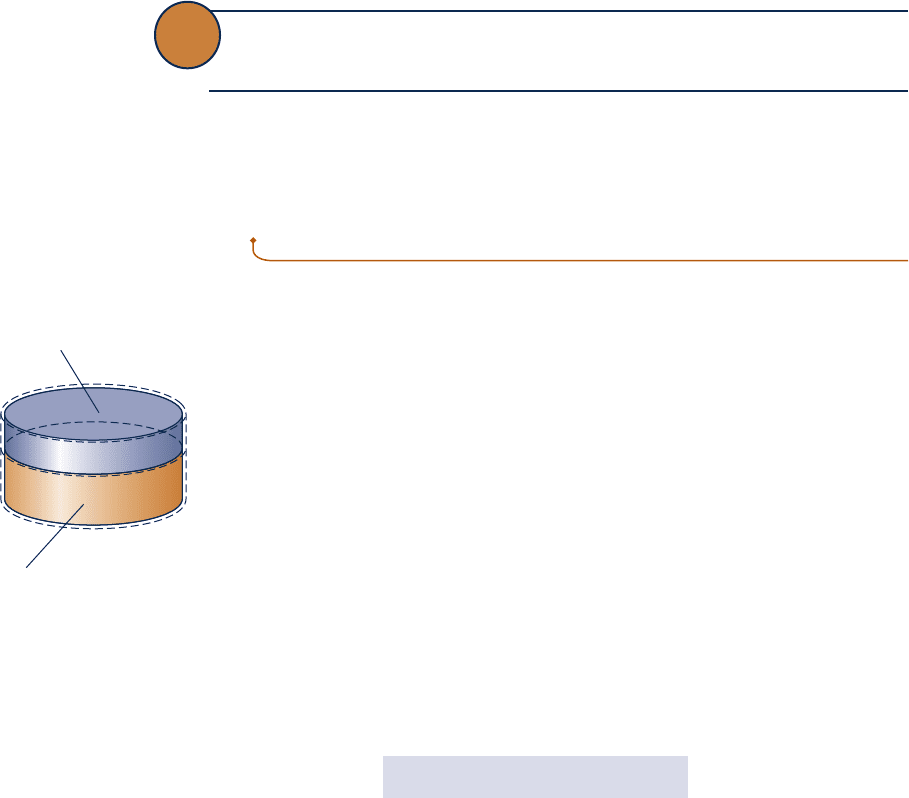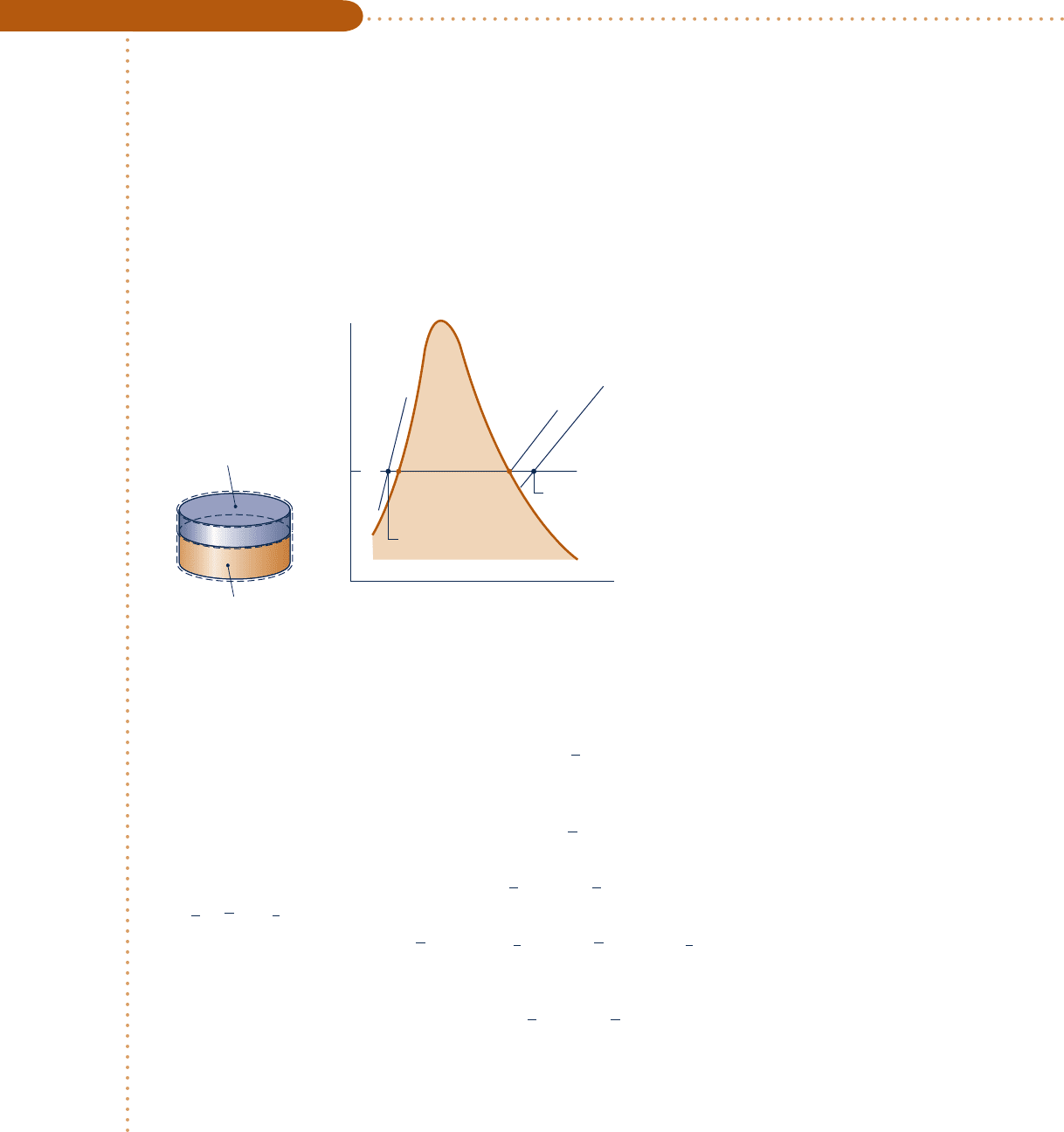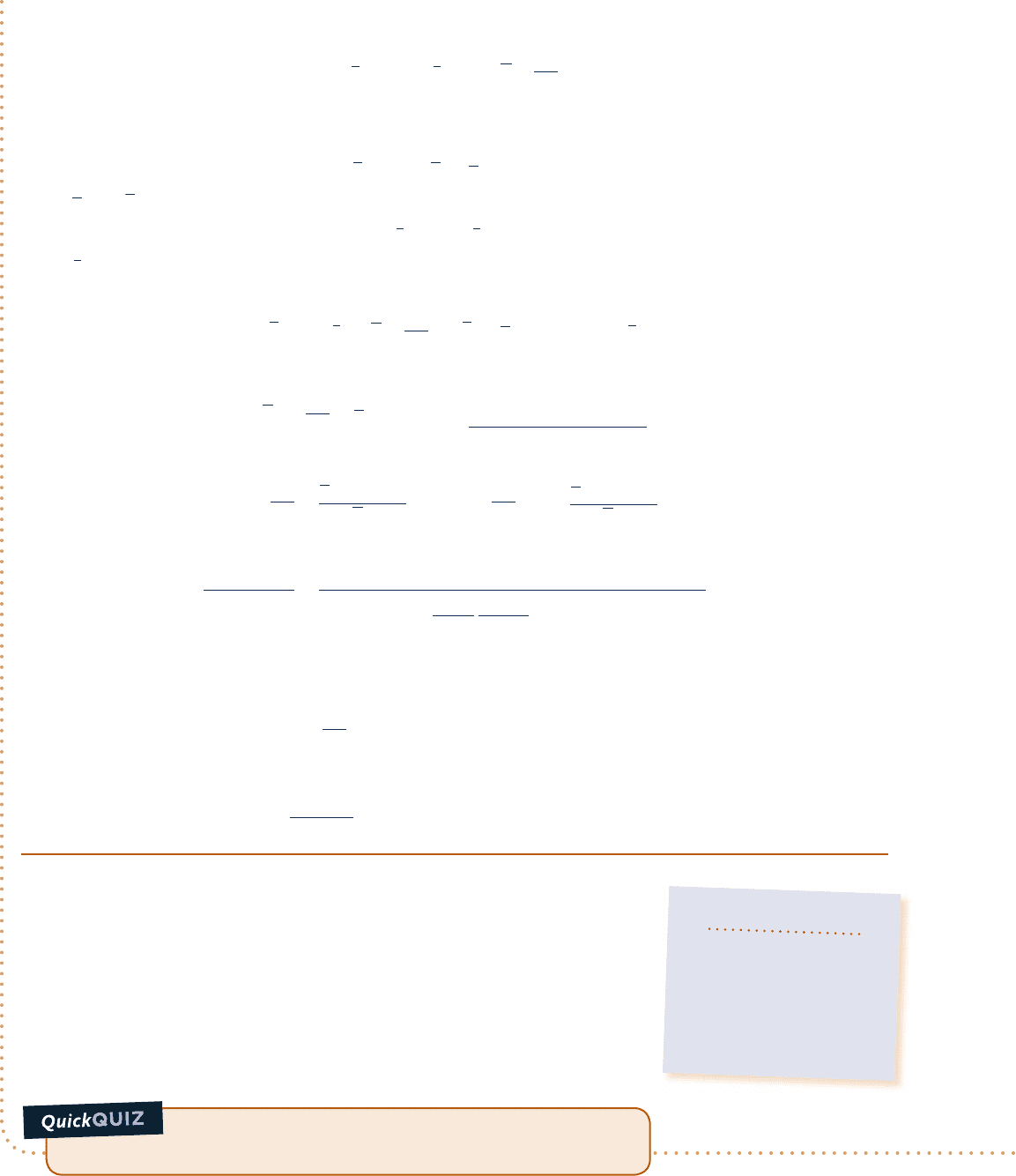Moran M.J., Shapiro H.N. Fundamentals of Engineering Thermodynamics
Подождите немного. Документ загружается.


and from Eq. 14.53 follows
K
2
5
y
v
M
M
y
v
N
N
y
v
A¿
A
y
v
L
L
a
p
p
ref
b
v
M
1v
N
2v
A¿
2v
L
(14.55)
The equilibrium constants K
1
and K
2
can be determined from Table A-27 or a
similar compilation. The mole fractions appearing in these expressions must be eval-
uated by considering all the substances present within the system, including the inert
substance E. Each mole fraction has the form y
i
5 n
i
/n, where n
i
is the amount of
component i in the equilibrium mixture and
n 5 n
A
1
n
B
1
n
C
1
n
D
1
n
E
1
n
L
1
n
M
1
n
N
(14.56)
The n’s appearing in Eq. 14.56 can be expressed in terms of two unknown variables
through application of the conservation of mass principle to the various chemical
species present. Accordingly, for a specified temperature and pressure, Eqs. 14.54 and
14.55 give two equations in two unknowns. The composition of the system at equilib-
rium can be determined by solving these equations simultaneously. This procedure is
illustrated by Example 14.9.
The procedure discussed in this section can be extended to systems involving sev-
eral simultaneous independent reactions. The number of simultaneous equilibrium
constant expressions that results equals the number of independent reactions. As
these equations are nonlinear and require simultaneous solution, the use of a com-
puter is usually required.
c c c c EXAMPLE 14.9 c
As a result of heating, a system consisting initially of 1 kmol of CO
2
,
1
2
kmol of O
2
, and
1
2
kmol of N
2
forms an
equilibrium mixture of CO
2
, CO, O
2
, N
2
, and NO at 3000 K, 1 atm. Determine the composition of the equilibrium
mixture.
SOLUTION
Known:
A system consisting of specified amounts of CO
2
, O
2
, and N
2
is heated to 3000 K, 1 atm, forming an
equilibrium mixture of CO
2
, CO, O
2
, N
2
, and NO.
Find: Determine the equilibrium composition.
Engineering Model: The final mixture is an equilibrium mixture of ideal gases.
Analysis: The overall reaction has the form
➊ 1CO
2
1
1
2
O
2
1
1
2
N
2
S
aCO 1 bNO 1 c CO
2
1 d O
2
1 eN
2
Applying conservation of mass to carbon, oxygen, and nitrogen, the five unknown coefficients can be expressed
in terms of any two of the coefficients. Selecting a and b as the unknowns, the following balanced equation
results:
1CO
2
1
1
2
O
2
1
1
2
N
2
S aCO 1 bNO 1
1
1 2 a
2
CO
2
1
1
2
1
1 1 a 2 b
2
O
2
1
1
2
1
1 2 b
2
N
2
The total number of moles n in the mixture formed by the products is
n 5 a 1 b 1 11 2 a21
1
2
11 1 a 2 b21
1
2
11 2 b25
4
1 a
2
At equilibrium, two independent reactions relate the components of the product mixture:
1. CO
2
d
S
CO 1
1
2
O
2
2.
1
2
O
2
1
1
2
N
2
d
S
NO
Considering Equilibrium with Simultaneous Reactions
14.4 Further Examples of the Use of the Equilibrium Constant 873
c14ChemicalandPhaseEquilibrium.873 Page 873 7/26/10 11:37:55 PM users-133 c14ChemicalandPhaseEquilibrium.873 Page 873 7/26/10 11:37:55 PM users-133 /Users/users-133/Desktop/Ramakant_04.05.09/WB00113_R1:JWCL170/New/Users/users-133/Desktop/Ramakant_04.05.09/WB00113_R1:JWCL170/New

874 Chapter 14 Chemical and Phase Equilibrium
Phase Equilibrium
In this part of the chapter the equilibrium condition dG
4
T,
p
5 0 introduced in Sec. 14.1
is used to study the equilibrium of multicomponent, multiphase, nonreacting systems.
The discussion begins with the elementary case of equilibrium between two phases of
a pure substance and then turns to the general case of several components present in
several phases.
Determine the mole fractions of the components of the equi-
librium mixture. Ans. y
CO
5 0.171, y
NO
5 0.031, y
CO
2
5 0.28
6
, y
O
2
5 0.299,
y
N
2
5 0.213.
For the first of these reactions, the form taken by the equilibrium constant when p 5 1 atm is
K
1
5
a3
1
2
11 1 a 2 b24
1
/
2
1
1 2 a
2
c
1
1
4 1 a
2
/
2
d
111
/
221
5
a
1 2 a
a
1 1 a 2 b
4 1 a
b
1
/
2
Similarly, the equilibrium constant for the second of the reactions is
K
2
5
b
3
1
2
1
1 1 a 2 b
24
1
/
2
3
1
2
1
1 2 b
24
1
/
2
c
1
14 1 a2
/
2
d
121
/
221
/
2
5
2b
31
1 1 a 2 b
2
1
1 2 b
24
1
/
2
At 3000 K, Table A-27 provides lo
g
10
K
1
520.485 and lo
g
10
K
2
520.913, giving K
1
5 0.3273 and K
2
5 0.1222.
Accordingly, the two equations that must be solved simultaneously for the two
unknowns a and b are
0.3273 5
a
1 2 a
a
1 1 a 2 b
4 1 a
b
1
/
2
,
0.1222 5
2b
31
1 1 a 2 b
2
1
1 2 b
24
1
/
2
The solution is a 5 0.3745, b 5 0.0675, as can be verified. The composition of
the equilibrium mixture, in kmol per kmol of CO
2
present initially, is then
0.3745CO, 0.0675NO, 0.6255CO
2
, 0.6535O
2
, 0.4663N
2
.
➊ If high enough temperatures are attained, nitrogen can combine with oxy-
gen to form components such as nitric oxide. Even trace amounts of oxides
of nitrogen in products of combustion can be a source of air pollution.
Ability to…
❑
apply Eq. 14.35 to deter-
mine equilibrium composition
given temperature and
pressure for two simultane-
ous equilibrium reactions.
❑
retrieve and use data from
Table A-27.
✓
Skills Developed
14.5 Equilibrium between Two Phases
of a Pure Substance
Consider the case of a system consisting of two phases of a pure substance at equi-
librium. Since the system is at equilibrium, each phase is at the same temperature
and pressure. The Gibbs function for the system is
G 5 n¿g¿
1
T, p
2
1 n–g–
1
T, p
2
(14.57)
where the primes 9 and 0 denote phases 1 and 2, respectively.
Forming the differential of G at fixed T and p
dG4
T,
p
5 g¿ dn¿ 1 g– dn– (14.58)
Since the total amount of the pure substance remains constant, an increase in the
amount present in one of the phases must be compensated by an equivalent decrease
c14ChemicalandPhaseEquilibrium.874 Page 874 8/12/10 9:47:09 AM user-s146 c14ChemicalandPhaseEquilibrium.874 Page 874 8/12/10 9:47:09 AM user-s146 /Users/user-s146/Desktop/Merry_X-Mas/New/Users/user-s146/Desktop/Merry_X-Mas/New

in the amount present in the other phase. Thus, we have dn0 5 2dn9, and Eq. 14.58
becomes
dG4
T,
p
5 1g¿ 2 g–2 dn¿
At equilibrium, dG
4
T,
p
5 0, so
g
¿ 5
g
– (14.59)
At equilibrium, the molar Gibbs functions of the phases are equal.
CLAPEYRON EQUATION. Equation 14.59 can be used to derive the Clapeyron
equation, obtained by other means in Sec. 11.4. For two phases at equilibrium, varia-
tions in pressure are uniquely related to variations in temperature: p 5 p
sat
1
T
2
; thus,
differentiation of Eq. 14.59 with respect to temperature gives
0
g¿
0T
b
p
1
0
g¿
0p
b
T
dp
sat
dT
5
0
g–
0T
b
p
1
0
g–
0p
b
T
dp
sat
dT
With Eqs. 11.30 and 11.31, this becomes
2s¿ 1 y ¿
dp
sat
dT
52s– 1 y–
dp
sat
d
T
Or on rearrangement
dp
sat
dT
5
s– 2 s¿
y
– 2
y
¿
This can be expressed alternatively by noting that, with
g
5 h 2 T s, Eq. 14.59
becomes
h¿ 2 T s¿ 5 h– 2 T s–
or
s– 2 s¿ 5
h– 2 h¿
T
(14.60)
Combining results, the Clapeyron equation is obtained
dp
sat
dT
5
1
T
a
h
– 2
h
¿
y–
2
y¿
b
(14.61)
An application of the Clapeyron equation is provided in Example 11.4.
A special form of Eq. 14.61 for a system at equilibrium consisting of a liquid or
solid phase and a vapor phase can be obtained simply. If the specific volume of the
liquid or solid, y¿, is negligible compared with the specific volume of the vapor, y–,
and the vapor can be treated as an ideal gas, y
– 5
R T
/
p
sat
, Eq. 14.61 becomes
dp
sat
dT
5
h– 2 h¿
RT
2
/
p
sat
or
d ln p
sat
dT
5
h
– 2
h
¿
RT
2
(14.62)
which is the Clausius–Clapeyron equation. The similarity in form of Eq. 14.62 and the
van’t Hoff equation, Eq. 14.43b, may be noted. The van’t Hoff equation for chemi-
cal equilibrium is the counterpart of the Clausius–Clapeyron equation for phase
equilibrium.
Clapeyron equation
Clausius–Clapeyron
equation
14.5 Equilibrium between Two Phases of a Pure Substance 875
TAKE NOTE...
Equations 11.40 and
11.42 are special cases
of Eqs. 14.61 and 14.62,
respectively.
c14ChemicalandPhaseEquilibrium.875 Page 875 7/26/10 11:37:58 PM users-133 c14ChemicalandPhaseEquilibrium.875 Page 875 7/26/10 11:37:58 PM users-133 /Users/users-133/Desktop/Ramakant_04.05.09/WB00113_R1:JWCL170/New/Users/users-133/Desktop/Ramakant_04.05.09/WB00113_R1:JWCL170/New

876 Chapter 14 Chemical and Phase Equilibrium
14.6 Equilibrium of Multicomponent,
Multiphase Systems
The equilibrium of systems that may involve several phases, each having a number
of components present, is considered in this section. The principal result is the Gibbs
phase rule, which summarizes important limitations on multicomponent, multiphase
systems at equilibrium.
14.6.1
Chemical Potential and Phase Equilibrium
Figure 14.1 shows a system consisting of two components A and B in two phases
1 and 2 that are at the same temperature and pressure. Applying Eq. 14.10 to
each of the phases
dG¿4
T,p
5 m¿
A
dn¿
A
1 m¿
B
dn¿
B
dG–4
T,p
5 m–
A
dn–
A
1 m–
B
dn–
B
(14.63)
where as before the primes identify the two phases.
When matter is transferred between the two phases in the absence of chem-
ical reaction, the total amounts of A and B must remain constant. Thus, the
increase in the amount present in one of the phases must be compensated by
an equivalent decrease in the amount present in the other phase. That is
dn
–
A
52dn
¿
A
,
dn
–
B
52dn
¿
B
(14.64)
With Eqs. 14.63 and 14.64, the change in the Gibbs function for the system is
dG
4
T,
p
5 dG¿
4
T,
p
1 dG–
4
T,
p
5
1m
¿
A
2
m
–
A
2
dn¿
A
1
1m
¿
B
2
m
–
B
2
dn¿
B
(14.65)
Since n9
A
and n9
B
can be varied independently, it follows that when dG4
T, p
5 0, the
terms in parentheses are zero, resulting in
m
¿
A
5 m
–
A
and
m
¿
B
5 m
–
B
(14.66)
At equilibrium, the chemical potential of each component is the same in each phase.
The significance of the chemical potential for phase equilibrium can be brought
out simply by reconsidering the system of Fig. 14.1 in the special case when the
chemical potential of component B is the same in both phases:
m¿
B
5
m–
B
. With this
constraint, Eq. 14.65 reduces to
dG
4
T,
p
5
1
m¿
A
2 m–
A
2
dn¿
A
Any spontaneous process of the system taking place at a fixed temperature and pres-
sure must be such that the Gibbs function decreases: dG
4
T,
p
, 0. Thus, with the above
expression we have
1m¿
A
2 m–
A
2dn¿
A
, 0
Accordingly,
c when the chemical potential of A is greater in phase 1 than in phase 2
1
m¿
A
. m–
A
2
,
it follows that dn
¿
A
, 0. That is, substance A passes from phase 1 to phase 2.
c when the chemical potential of A is greater in phase 2 than in phase 1
1m
–
A
.
m
¿
A
2
,
it follows that dn
¿
A
. 0. That is, substance A passes from phase 2 to phase 1.
At equilibrium, the chemical potentials are equal
1m
¿
A
5
m
–
A
2
, and there is no net
transfer of A between the phases.
With this reasoning, we see that the chemical potential can be regarded as a measure
of the escaping tendency of a component. If the chemical potential of a component is not
the same in each phase, there will be a tendency for that component to pass from the
Fig. 14.1 System consisting of two
components in two phases.
Phase 2
Component A, n´´
A
, ´´
A
Component B, n´´
B
, ´´
B
µ
µ
Phase 1
Component A, n´
A
, ´
A
Component B, n´
B
, ´
B
µ
µ
c14ChemicalandPhaseEquilibrium.876 Page 876 7/27/10 1:00:10 AM users-133 c14ChemicalandPhaseEquilibrium.876 Page 876 7/27/10 1:00:10 AM users-133 /Users/users-133/Desktop/Ramakant_04.05.09/WB00113_R1:JWCL170/New/Users/users-133/Desktop/Ramakant_04.05.09/WB00113_R1:JWCL170/New

phase having the higher chemical potential for that component to the phase having the
lower chemical potential. When the chemical potential is the same in both phases, there
is no tendency for a net transfer to occur from one phase to the other.
In Example 14.10, we apply phase equilibrium principles to provide a rationale for
the model introduced in Sec. 12.5.3 for moist air in contact with liquid water.
14.6 Equilibrium of Multicomponent, Multiphase Systems 877
c c c c EXAMPLE 14.10 c
A closed system at a temperature of
70
8F and a pressure of 1 atm consists of a pure liquid water phase in equi-
librium with a vapor phase composed of water vapor and dry air. Determine the departure, in percent, of the
partial pressure of the water vapor from the saturation pressure of water at 70°F.
SOLUTION
Known:
A phase of liquid water only is in equilibrium with moist air at 70°F and 1 atm.
Find: Determine the percentage departure of the partial pressure of the water vapor in the moist air from the
saturation pressure of water at 70°F.
Schematic and Given Data:
Evaluating Equilibrium of Moist Air in Contact with Liquid Water
Engineering Model:
1.
The gas phase can be modeled as an ideal
gas mixture.
2. The liquid phase is pure water only.
Analysis: For phase equilibrium, the chemical potential of the water must have the same value in both phases:
m
1
5 m
v
, where m
1
and m
v
denote, respectively, the chemical potentials of the pure liquid water in the liquid phase
and the water vapor in the vapor phase.
The chemical potential m
1
is the Gibbs function per mole of pure liquid water (Eq. 14.12)
m
1
5 g 1T, p2
Since the vapor phase is assumed to form an ideal gas mixture, the chemical potential m
v
equals the Gibbs func-
tion per mole evaluated at temperature T and the partial pressure p
v
of the water vapor (Eq. 14.16)
m
v
5 g 1T, p
v
2
For phase equilibrium, m
1
5 m
v
, or
g 1T, p
v
25 g 1T, p2
With g 5 h 2 T s, this can be expressed alternatively as
h 1T, p
v
22 T s 1T, p
v
25 h 1T, p22 T s 1T, p2
The water vapor is modeled as an ideal gas. Thus, the enthalpy is given closely by the saturated vapor value
at temperature T
h 1T, p
v
2< h
g
Fig. E14.10
70°F
Gas phase of
water vapor
and dry air
Liquid water
T
v
p = 1 atm
Sat. liquid
Sat. vapor
State of
the liquid
State of
the water
vapor
f
g
p
v
p
sat
➊
c14ChemicalandPhaseEquilibrium.877 Page 877 7/26/10 11:38:01 PM users-133 c14ChemicalandPhaseEquilibrium.877 Page 877 7/26/10 11:38:01 PM users-133 /Users/users-133/Desktop/Ramakant_04.05.09/WB00113_R1:JWCL170/New/Users/users-133/Desktop/Ramakant_04.05.09/WB00113_R1:JWCL170/New

878 Chapter 14
Chemical and Phase Equilibrium
Furthermore, the relationship between the specific entropy of the water vapor and the specific entropy at the
corresponding saturated vapor state is
s 1T, p
v
25 s
g
1T 22 R ln
p
v
p
sat
where p
sat
is the saturation pressure at temperature T (see Sec. 12.5.2 for discussion).
With Eq. 3.13, the enthalpy of the liquid is closely
h 1T, p2< h
f
1 y
f
1p 2 p
sat
2
where y
f
and h
f
are the saturated liquid specific volume and enthalpy at temperature T. Furthermore, with Eq. 6.5
s 1T, p2< s
f
1T 2
where s
f
is the saturated liquid specific entropy at temperature T.
Collecting the foregoing expressions, we have
h
g
2 T as
g
2 R ln
p
v
p
sat
b5 h
f
1 y
f
1p 2 p
sat
22 T s
f
or
RT ln
p
v
p
sat
5
y
f
1p 2 p
sat
22 31h
g
2 h
f
22 T 1s
g
2 s
f
24
The underlined term vanishes by Eq. 14.60, leaving
ln
p
v
p
sat
5
y
f
1p 2 p
sat
2
RT
or
p
v
p
sat
5 exp
y
f
1p 2 p
sat
2
RT
With data from Table A-2E at 70°F, y
f
5 0.01605 ft
3
/lb and p
sat
5 0.3632 lbf/in.
2
, we have on a mass basis
y
f
1
p 2 p
sat
2
RT
5
0.01605 ft
3
/
lb 114.696 2 0.36322 1lbf
/
in.
2
2 0144 in.
2
/
ft
2
0
a
154
5
18.02
ft ? lbf
lb ? 8R
b 15308R2
5 7.29 3 10
24
Finally
p
v
p
sat
5 exp 17.29 3 10
24
25 1.00073
When expressed as a percentage, the departure of p
v
from p
sat
is
➋
a
p
v
2 p
sat
p
sat
b110025 11.00073 2 12110025 0.073%
➊ For phase equilibrium, there would be a small, but finite, concentration of air
in the liquid water phase. However, this small amount of dissolved air is
ignored in the present development.
➋ The departure of p
v
from p
sat
is negligible at the specified conditions. This sug-
gests that at normal temperatures and pressures the equilibrium between the
liquid water phase and the water vapor is not significantly disturbed by the
presence of the dry air. Accordingly, the partial pressure of the water vapor can
be taken as equal to the saturation pressure of the water at the system tem-
perature. This model, introduced in Sec. 12.5.3, is used extensively in Chap. 12.
Ability to…
❑
apply the concept of phase
equilibrium expressed by
Eqs. 14.66 to an air–water
vapor mixture in equilibrium
with liquid water.
✓
Skills Developed
Using the methods of Sec. 12.5.2, determine the humidity ratio,
v, of the air–water vapor mixture. Ans. 0.01577 lb(vapor)/lb(dry air).
c14ChemicalandPhaseEquilibrium.878 Page 878 8/12/10 8:42:47 AM user-s146 c14ChemicalandPhaseEquilibrium.878 Page 878 8/12/10 8:42:47 AM user-s146 /Users/user-s146/Desktop/Merry_X-Mas/New/Users/user-s146/Desktop/Merry_X-Mas/New

14.6.2
Gibbs Phase Rule
The requirement for equilibrium of a system consisting of two components and two
phases, given by Eqs. 14.66, can be extended with similar reasoning to nonreacting
multicomponent, multiphase systems. At equilibrium, the chemical potential of each
component must be the same in all phases. For the case of N components that are
present in P phases we have, therefore, the following set of N(P 2 1) equations:
P 2
1
N
d
m
1
1
5 m
2
1
5 m
3
1
5
. . .
5 m
P
1
m
1
2
5 m
2
2
5 m
3
2
5
. . .
5 m
P
2
.
.
.
m
1
N
5 m
2
N
5 m
3
N
5
. . .
5 m
P
N
(14.67)
where
m
j
i
denotes the chemical potential of the ith component in the jth phase. This
set of equations provides the basis for the Gibbs phase rule, which allows the deter-
mination of the number of independent intensive properties that may be arbitrarily
specified in order to fix the intensive state of the system. The number of independent
intensive properties is called the degrees of freedom (or the variance).
Since the chemical potential is an intensive property, its value depends on the
relative proportions of the components present and not on the amounts of the com-
ponents. In other words, in a given phase involving N components at temperature T
and pressure p, the chemical potential is determined by the mole fractions of the
components present and not the respective n’s. However, as the mole fractions add
to unity, at most N 2 1 of the mole fractions can be independent. Thus, for a system
involving N components, there are at most N 2 1 independently variable mole frac-
tions for each phase. For P phases, therefore, there are at most P(N 2 1) indepen-
dently variable mole fractions. In addition, the temperature and pressure, which are
the same in each phase, are two further intensive properties, giving a maximum of
P(N 2 1) 1 2 independently variable intensive properties for the system. But because
of the N(P 2 1) equilibrium conditions represented by Eqs. 14.67 among these
properties, the number of intensive properties that are freely variable, the degrees
of freedom F, is
F 5 3P1N 2 121 242 N1P 2 125 2 1 N 2 P (14.68)
which is the Gibbs phase rule.
In Eq. 14.68, F is the number of intensive properties that may be arbitrarily spec-
ified and that must be specified to fix the intensive state of a nonreacting system at
equilibrium.
let us apply the Gibbs phase rule to a liquid solution consisting
of water and ammonia such as considered in the discussion of absorption refrigeration
(Sec. 10.5). This solution involves two components and a single phase: N 5 2 and P 5 1.
Equation 14.68 then gives F 5 3, so the intensive state is fixed by giving the values of
three intensive properties, such as temperature, pressure, and the ammonia (or water)
mole fraction. b b b b b
The phase rule summarizes important limitations on various types of systems. For
example, for a system involving a single component such as water, N 5 1 and Eq. 14.68
becomes
F 5 3 2 P (14.69)
c The minimum number of phases is one, corresponding to P 5 1. For this case, Eq. 14.69
gives F 5 2. That is, two intensive properties must be specified to fix the intensive
μ
degrees of freedom
Gibbs phase rule
14.6 Equilibrium of Multicomponent, Multiphase Systems 879
c14ChemicalandPhaseEquilibrium.879 Page 879 7/26/10 11:38:05 PM users-133 c14ChemicalandPhaseEquilibrium.879 Page 879 7/26/10 11:38:05 PM users-133 /Users/users-133/Desktop/Ramakant_04.05.09/WB00113_R1:JWCL170/New/Users/users-133/Desktop/Ramakant_04.05.09/WB00113_R1:JWCL170/New

880 Chapter 14 Chemical and Phase Equilibrium
state of the system. This requirement is familiar from our use of the steam tables
and similar property tables. To obtain properties of superheated vapor, say, from
such tables requires that we give values for any two of the tabulated properties,
for example, T and p.
c When two phases are present in a system involving a single component, N 5 1 and
P 5 2. Equation 14.69 then gives F 5 1. That is, the intensive state is determined
by a single intensive property value. For example, the intensive states of the sepa-
rate phases of an equilibrium mixture of liquid water and water vapor are com-
pletely determined by specifying the temperature.
c The minimum allowable value for the degrees of freedom is zero: F 5 0. For a
single-component system, Eq. 14.69 shows that this corresponds to P 5 3, a three-
phase system. Thus, three is the maximum number of different phases of a pure
component that can coexist in equilibrium. Since there are no degrees of freedom,
both temperature and pressure are fixed at equilibrium. For example, there is only
a single temperature 0.01°C (32.02°F) and a single pressure 0.6113 kPa (0.006 atm)
for which ice, liquid water, and water vapor are in equilibrium.
The phase rule given here must be modified for application to systems in which
chemical reactions occur. Furthermore, the system of equations, Eqs. 14.67, giving the
requirements for phase equilibrium at a specified temperature and pressure can be
expressed alternatively in terms of partial molal Gibbs functions, fugacities, and
activities, all of which are introduced in Sec. 11.9. To use any such expression to
determine the equilibrium composition of the different phases present within a system
at equilibrium requires a model for each phase that allows the relevant quantities—
the chemical potentials, fugacities, and so on—to be evaluated for the components
present in terms of system properties that can be determined. For example, a gas
phase might be modeled as an ideal gas mixture or, at higher pressures, as an ideal
solution.
In this chapter, we have studied chemical equilibrium and phase
equilibrium. The chapter opens by developing criteria for equilib-
rium and introducing the chemical potential. In the second part
of the chapter, we study the chemical equilibrium of ideal gas
mixtures using the equilibrium constant concept. We also utilize
the energy balance and determine the equilibrium flame tem-
perature as an application. The final part of the chapter concerns
phase equilibrium, including multicomponent, multiphase sys-
tems and the Gibbs phase rule.
The following list provides a study guide for this chapter.
When your study of the text and end-of-chapter exercises has
been completed, you should be able to
c
write out the meaning of the terms listed in the margin
throughout the chapter and understand each of the related
concepts. The subset of key concepts listed below is particu-
larly important.
c
apply the equilibrium constant relationship, Eq. 14.35, to
determine the third quantity when any two of temperature,
pressure, and equilibrium composition of an ideal gas mixture
are known. Special cases include applications with simultane-
ous reactions and systems involving ionized gases.
c
use chemical equilibrium concepts with the energy balance,
including determination of the equilibrium flame temperature.
c
apply Eq. 14.43b, the van’t Hoff equation, to determine the
enthalpy of reaction when the equilibrium constant is known,
and conversely.
c
apply the Gibbs phase rule, Eq. 14.68.
c CHAPTER SUMMARY AND STUDY GUIDE
c KEY ENGINEERING CONCEPTS
Gibbs function, p. 849
equilibrium criterion, p. 849
chemical potential, p. 850
equation of reaction equilibrium, p. 855
equilibrium constant, p. 856
equilibrium flame temperature, p. 865
Gibbs phase rule, p. 879
c14ChemicalandPhaseEquilibrium.880 Page 880 7/26/10 11:38:06 PM users-133 c14ChemicalandPhaseEquilibrium.880 Page 880 7/26/10 11:38:06 PM users-133 /Users/users-133/Desktop/Ramakant_04.05.09/WB00113_R1:JWCL170/New/Users/users-133/Desktop/Ramakant_04.05.09/WB00113_R1:JWCL170/New

c EXERCISES: THINGS ENGINEERS THINK ABOUT
1. Why is using the Gibbs function advantageous when studying
chemical and phase equilibrium?
2. For Eq. 14.6 to apply at equilibrium, must a system attain
equilibrium at fixed T and p?
3. Show that (dA)
T,V
5 0 is a valid equilibrium criterion, where
A 5 U 2 TS is the Helmholtz function.
4. A mixture of 1 kmol of CO and
1
2
kmol of O
2
is held at
ambient temperature and pressure. After 100 hours only an
insignificant amount of CO
2
has formed. Why?
5. Why might oxygen contained in an iron tank be treated as
inert in a thermodynamic analysis even though iron oxidizes
in the presence of oxygen?
6. For
CO
2
1 H
2
S
d
CO
1 H
2
O
, how does pressure affect the
equilibrium composition?
7. For each of the reactions listed in Table A-27, the value of log
10
K
increases with increasing temperature. What does this imply?
8. For each of the reactions listed in Table A-27, the value of
the equilibrium constant K at 298 K is relatively small. What
does this imply?
9. If a system initially containing CO
2
and H
2
O were held at
fixed T, p, list chemical species that might be present at
equilibrium.
10. Using Eq. 14.12 together with phase equilibrium consi-
derations, suggest how the chemical potential of a mixture
component could be evaluated.
11. Note 1 of Example 14.10 refers to the small amount of air
that would be dissolved in the liquid phase. For equilibrium,
what must be true of the chemical potentials of air in the
liquid and gas phases?
12. Water can exist in a number of different solid phases. Can
liquid water, water vapor, and two phases of ice exist in
equilibrium?
Exercises: Things Engineers Think About 881
c KEY EQUATIONS
dG4
T, p
5 0 (14.6) p. 849 Equilibrium criterion
m
i
5 a
0G
0n
i
b
T, p, n
l
(14.8) p. 850 Chemical potential of component i in a mixture.
G 5
a
j
i51
n
i
g
i
1T, p
i
2
(14.15) p. 851
m
i
5 g
i
1T, p
i
2 (14.16) p. 851
m
i
5 g
i
81RT ln
y
i
p
p
ref
(14.17) p. 852
K1T25
y
n
C
C
y
n
D
D
y
n
A
A
y
n
B
B
a
p
p
ref
b
n
C
1n
D
2n
A
2n
B
(14.32) p. 856
K 5
n
n
C
C
n
n
D
D
n
n
A
A
n
n
B
B
a
p
/
p
ref
n
b
n
C
1n
D
2n
A
2n
B
(14.35) p. 858
d ln K
dT
5
¢H
RT
2
(14.43b) p. 869 van’t Hoff equation.
g¿ 5 g–
(14.59) p. 875 Phase equilibrium criterion for a pure substance
m¿
A
5 m–
A
m¿
B
5
m–
B
(14.66) p. 876
F 5 2 1
N
2 P (14.68) p. 879 Gibbs phase rule.
Equilibrium constant expressions for an equilibrium mixture
of ideal gases.
Gibbs function and chemical potential relations for ideal
gas mixtures.
Phase equilibrium criteria for two-component,
two-phase systems.
c14ChemicalandPhaseEquilibrium.881 Page 881 7/26/10 11:38:06 PM users-133 c14ChemicalandPhaseEquilibrium.881 Page 881 7/26/10 11:38:06 PM users-133 /Users/users-133/Desktop/Ramakant_04.05.09/WB00113_R1:JWCL170/New/Users/users-133/Desktop/Ramakant_04.05.09/WB00113_R1:JWCL170/New

882 Chapter 14
Chemical and Phase Equilibrium
c PROBLEMS: DEVELOPING ENGINEERING SKILLS
Working with the Equilibrium Constant
14.1 Determine the change in the Gibbs function DG8 at 258C
in kJ/kmol, for the reaction
CH
4
1g21 2O
2
d
S
CO
2
1 2H
2
O1g2
using
(a) Gibbs function of formation data.
(b) enthalpy of formation and absolute entropy data.
14.2 Calculate the equilibrium constant, expressed as log
10
K,
for CO
2
d
S
CO 1
1
2
O
2
at (a) 500 K, (b) 18008R. Compare with
values from Table A-27.
14.3 Calculate the equilibrium constant, expressed as
l
og
10
K,
for the water-gas shift reaction CO 1 H
2
O
1
g
2
d
S
CO
2
1 H
2
at
(a) 298 K, (b) 1000 K. Compare with values from Table A-27.
14.4 Calculate the equilibrium constant, expressed as
l
o
g
1
0
K,
for H
2
O
d
S
H
2
1
1
2
O
2
at (a) 298 K, (b) 36008R. Compare
with values from Table A-27.
14.5 Using data from Table A-27, determine log
10
K at 2500 K for
(a) H
2
O
d
S
H
2
1
1
2
O
2
.
(b) H
2
1
1
2
O
2
d
S
H
2
O.
(c) 2H
2
O
d
S
2H
2
1 O
2
.
14.6 In Table A-27, log
10
K is nearly linear in 1yT: log
10
K 5
C
1
1 C
2
/
T, where C
1
and C
2
are constants. For selected reac-
tions listed in the table
(a) verify this by plotting log
10
K versus 1/T for temperature
ranging from 2100 to 2500 K.
(b) evaluate C
1
and C
2
for any pair of adjacent table entries
in the temperature range of part (a).
14.7 Determine the relationship between the ideal gas equilibrium
constants K
1
and K
2
for the following two alternative ways of
expressing the ammonia synthesis reaction:
1.
1
2
N
2
1
3
2
H
2
d
S
NH
3
2. N
2
1 3H
2
d
2
S
NH
3
14.8 Consider the reactions
1. CO 1 H
2
O
d
S
H
2
1 CO
2
2. 2CO
2
d
S
2CO 1 O
2
3. 2H
2
O
d
S
2H
2
1 O
2
Show that K
1
5
1
K
3
/
K
2
2
1
/
2
.
14.9 Consider the reactions
1. CO
2
1 H
2
d
S
CO 1 H
2
O
2. CO
d
S
CO 1
1
2
O
2
3. H
2
O
d
S
H
2
1
1
2
O
2
(a) Show that K
1
5 K
2
/
K
3
.
(b) Evaluate 1og
10
K
1
at 298 K, 1 atm using the expression from
part (a), together with 1og
10
K data from Table A-27.
(c) Check the value for 1og
10
K
1
obtained in part (b) by
applying Eq. 14.31 to reaction 1.
14.10 Evaluate the equilibrium constant at 2000 K for
CH
4
1 H
2
O
d
S
3H
2
1 CO. At 2000 K, log
10
K 5 7.469 for
C 1
1
2
O
2
d
S
CO, and log
10
K 523.408 for C 1 2H
2
d
S
CH
4
.
14.11 For each of the following dissociation reactions, determine
the equilibrium compositions:
(a) One kmol of N
2
O
4
dissociates to form an equilibrium
ideal gas mixture of N
2
O
4
and NO
2
at 25°C, 2 atm. For
N
2
O
4
d
S
2NO
2
, ¢G855400 kJ
/
kmol at 25°C.
(b) One kmol of CH
4
dissociates to form an equilibrium
ideal gas mixture of CH
4
, H
2
, and C at 1000 K, 5 atm. For
C 1 2H
2
d
S
CH
4
, log
10
K 5 1.011 at 1000 K.
14.12 Determine the extent to which dissociation occurs in the
following cases: One lbmol of H
2
O dissociates to form an
equilibrium mixture of H
2
O, H
2
, and O
2
at 47408F, 1.25 atm.
One lbmol of CO
2
dissociates to form an equilibrium mixture
of CO
2
, CO, and O
2
at the same temperature and pressure.
14.13 One lbmol of carbon reacts with 2 lbmol of oxygen (O
2
)
to form an equilibrium mixture of CO
2
, CO, and O
2
at 49408F,
1 atm. Determine the equilibrium composition.
14.14 The following exercises involve oxides of nitrogen:
(a) One kmol of N
2
O
4
dissociates at 258C, 1 atm to form an
equilibrium ideal gas mixture of N
2
O
4
and NO
2
in which the
amount of N
2
O
4
present is 0.8154 kmol. Determine the
amount of N
2
O
4
that would be present in an equilibrium
mixture at 258C, 0.5 atm.
(b) A gaseous mixture consisting of 1 kmol of NO, 10 kmol
of O
2
, and 40 kmol of N
2
reacts to form an equilibrium
ideal gas mixture of NO
2
, NO, and O
2
at 500 K, 0.1 atm.
Determine the composition of the equilibrium mixture. For
NO 1
1
2
O
2
d
S
NO
2
, K 5 120 at 500 K.
(c) An equimolar mixture of O
2
and N
2
reacts to form an
equilibrium ideal gas mixture of O
2
, N
2
, and NO. Plot the mole
fraction of NO in the equilibrium mixture versus equilibrium
temperature ranging from 1200 to 2000 K.
Why are oxides of nitrogen of concern?
14.15 One kmol of CO
2
dissociates to form an equilibrium
ideal gas mixture of CO
2
, CO, and O
2
at temperature T and
pressure p.
(a) For T 5 3000 K, plot the amount of CO present, in kmol,
versus pressure for 1 # p # 10 atm.
(b) For p 5 1 plot the amount of CO present, in kmol, versus
temperature for 2000 # T # 3500 K.
14.16 One lbmol of H
2
O dissociates to form an equilibrium
ideal gas mixture of H
2
O, H
2
, and O
2
at temperature T and
pressure p.
(a) For T 5 54008R, plot the amount of H
2
present, in lbmol,
versus pressure ranging from 1 to 10 atm.
(b) For p 5 1 atm, plot the amount of H
2
present, in lbmol,
versus temperature ranging from 3600 to 63008R.
14.17 One lbmol of H
2
O together with x lbmol of N
2
(inert)
forms an equilibrium mixture at 54008R, 1 atm consisting of
H
2
O, H
2
, O
2
, and N
2
. Plot the amount of H
2
present in the
equilibrium mixture, in lbmol, versus x ranging from 0 to 2.
14.18 An equimolar mixture of CO and O
2
reacts to form an
equilibrium mixture of CO
2
, CO, and O
2
at 3000 K.
Determine the effect of pressure on the composition of the
c14ChemicalandPhaseEquilibrium.882 Page 882 8/12/10 9:57:17 AM user-s146 c14ChemicalandPhaseEquilibrium.882 Page 882 8/12/10 9:57:17 AM user-s146 /Users/user-s146/Desktop/Merry_X-Mas/New/Users/user-s146/Desktop/Merry_X-Mas/New
